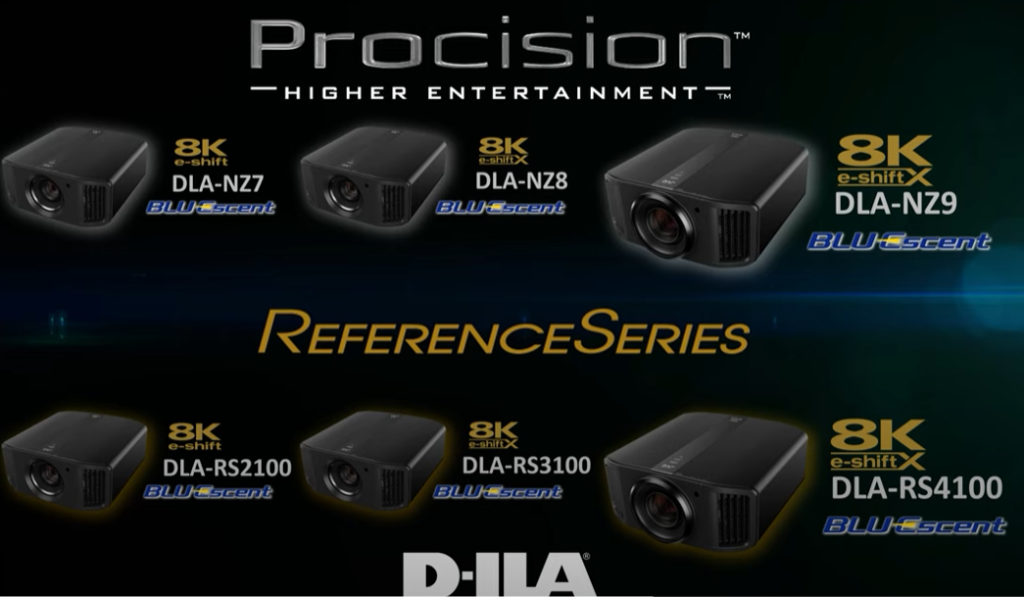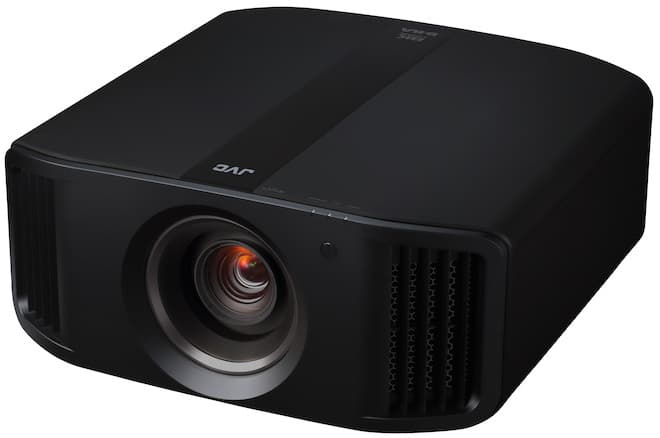JVC 8K e-Shift Laser Projectors
JVC has announced three (technically six but really three) new 8k e-Shift laser driver projectors. This has got the home theater world talking and we wanted to break down the important bits for you. Yes, these will accept 4k/120Hz input. Yes, most will display 8k/60Hz. They are also HDMI 2.1 compatible. But before you go out and preorder one, let’s dive in and look more closely at these new projectors from JVC.
Feature Breakdown
There are three new projectors that are in slightly different chassis. The Procision Series has model numbers that start with NZ and the Reference Series has model numbers that start with RS. Functionally, however, the NZ7 and the RX2100 are the same, the NZ8 and the RS3100 are the same, and the NZ9 and RS4100 are the same. The Procision Series with their NZ models are consumer level with the Reference Series targetted at custom installers. Functionally, they are the same projectors. So, if you see a price drop on one, but not the other, pick up the cheaper one. Here are some of the common features:
- 3-Chip DILA – one for each color red, green, and blue.
- BLU-Escent laser light source
- HDMI 2.1 with native 4 resolution
- e-Shift to achieve ~8k resolution
- HDR10/10+ support
- Dynamic Tone Mapping
- 3D Support (extra purchase required)
- ISF Certified

Picture
One of the questions you might have is about brightness. As you might expect, these projectors go up in lumens as they go up in price. The most expensive, the NZ9 and RS4100 have 3000 lumens and 100,000:1 contrast ratio. The NZ8/RS3100 have 2500 lumens and 80,000: 1 contrast while the NZ7/RS2100 has 2200 lumens and 40,000:1 contrast. The top two projectors deliver 80% of the Rec. 2020 color space (over 100% of DCI/P3 color) and sport the newer 8K e-ShiftX while the NZ7/RS2100 will provide 93% of DCI/P3 and has regular 8k e-Shift. The most expensive (NZ9/RS4100) sports a 100mm diameter lens while the other two have a 65mm diameter lenses.

e-Shift
You may be wondering what is the difference between the 8k-eShift and e-ShiftX. When 4k first hit the streets, true 4k projectors were hard to find and very expensive. To combat that, manufacturers starting taking 1080p panels and “wobbling” the light output so that they could up the resolution to 4k without significantly increasing the cost. JVC is doing the same with their 8K e-Shift laser projectors.
For the least expensive models, the NZ7 and RS2100, they have included regular 8k e-Shift. This ups the resolution from the almost 9 million pixels of a 4k panel to 17.7 million pixels. They do this by wobbling the light twice so that it doubles the pixel count. The 8k-eShiftX increases that to over 35 million by wobbling the light four times. That means that the NZ7 and RS2100 aren’t actually giving you 8k resolution while the other two are.
Author’s Note: Technically, 8k resolution is 7,680 by 4,320 or just over 33 million pixels. The JVC projectors are displaying more pixels than that.

Laser Light Engine
Everyone is very excited about lasers in their projectors. They are brighter, they last longer, and they make it possible to do better HDR with a projector. But the question we always have is how do you service them. The JVC laser engines in their 8k e-Shift projectors are predicted to have a half-life (reduce their brightness by half) of 20,000 hours. That’s a long time. But there doesn’t seem to be a way to user-service these projectors. Once the laser source starts to dim, the only solution seems to be to either have a certified technician replace it, or to send it off for replacement. Either way, JVC has promised that high-usage owners would not have to replace the entire projector.
Pricing and Availability
JVC promises that their 8k e-Shift laser projectors will be available starting next month (October 2021). Pricing is:
Our Take
There is a lot to like in the JVC 8k e-Shift laser projector lineup. The HDR10/10+ support is great, the dynamic tone mapping is great to hear, and the calibration features are a nice plus. For that last one, custom installers will love the ISF certification (allows them to use the professional ISF calibration tools) while normal users get access to auto-calibration and screen correction modes. For the auto-calibration feature, you’ll need to buy a supported optical sensor.
Sure, these projectors are expensive, but they are just about what we’d expect for what they can do. They are super bright, have the latest HDMI features and resolution, and a very wide color gamut. While this still won’t stand up to the performance of an OLED, they are getting quite a bit closer. And when you are trying to stay relevant in the display world, having HDR support and 8k resolution paired with a much larger picture size is the way to do it.


